Nicias › Labyrinth » Ancient origins
Articles and Definitions › Contents
- Nicias › Who Was
- Labyrinth › Antique Origins
Ancient civilizations › Historical and archaeological sites
Nicias › Who Was
Definition and Origins

Nicias, or Nikias (c. 470-413 BCE), was a wealthy Athenian politician and general during the Peloponnesian War (431-404 BCE). He became established as a prominent political leader of the aristocratic faction in Athenian politics and generally recommended a cautious line in opposition to the more hawkish anti-Spartan attitudes of popular leaders such as Cleon and Alcibiades. After the death of Cleon (422 BCE), he negotiated the Peace of Nicias with Sparta, temporarily ending the Peloponnesian War. As a general he was known for his prudence, and he argued against launching the Sicilian Expedition.Nonetheless, he still joined the campaign when chosen as one of its generals. Despite the high risks involved, the campaign came close to success; however, when the tide turned against Athens, Nicias' indecision hindered the Athenian escape.Captured by the Syracusans, Nicias and his fellow general Demosthenes were executed.
EARLY LIFE
Nicias, the son of Niceratus, was descended from an aristocratic Athenian family. He was extremely wealthy, and Xenophonrelated that Nicias owned 1,000 slaves who were hired out for an obol a day each to work in the silver mines at Laurium ( Ways and Means, 14). As a representative of the wealthy conservative faction, Nicias often came into conflict with Cleon.Unlike Pericles, who had won support from the masses "by virtue of his natural superiority and the force of his eloquence," Nicias "was exceptionally rich and used his wealth to win their favour" ( Plutarch, Life of Nicias, 3). Plutarch was writingaround 500 years after the death of Nicias, but he records that a statue of Athena and a shrine to Dionysus, paid for by Nicias, were still visible in his day. Nicias was well-known for his piety, and he sacrificed to the gods every day; however, his reliance on diviners would ultimately contribute to his downfall.
THE EARLY PELOPONNESIAN WAR
NICIAS' COMBINATION OF COMPETENCE AND CAUTION ENSURED THAT HIS CAMPAIGNS LARGELY MET WITH NEITHER TRIUMPH NOR DISASTER.
Nicias was frequently elected as a strategos, one of ten annually elected generals, during the 420s BCE. His combination of competence and caution ensured that his campaigns largely met with neither triumph nor disaster.
In 427 BCE, Nicias led an Athenian campaign against Minoa, an island close to Megara opposite Salamis. The Megarians had fortified the island and used it as a base from which to harass Athenian shipping. Nicias conquered the island within a few days and garrisoned it. The following year, he led a force of 60 ships and 2,000 hoplites against the island of Melos but failed to capture the island after devastating their land. His fleet then raided Theban and Locrian territory before returning to Athens.
In 425 BCE, Cleon attacked Nicias for his over-cautious approach and announced that Athens could capture Pylos from the Spartans if they only had more daring generals. Nicias then declined to lead the attack on Pylos and suggested that Cleon go instead. The assembly agreed and Cleon, with the assistance of Demosthenes, defeated and captured the Spartan force at Pylos. Nicias instead led another large fleet, this time containing 80 ships, against the territory of Corinth. The Athenians defeated a Corinthian army on land but then retreated to their ships as Corinthian reinforcements arrived. They then landed at and fortified a peninsular close to Epidaurus, before returning to Athens.
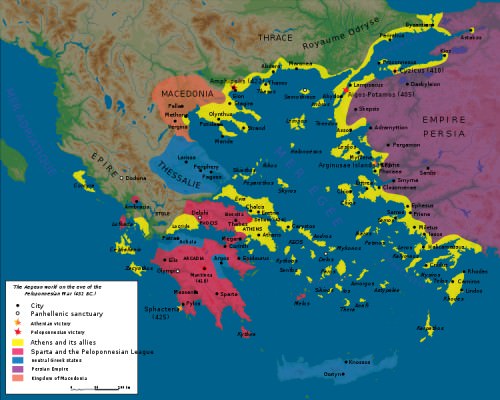
Peloponnesian War
In 424 BCE, Nicias led his most significant campaign to date, commanding a fleet of 60 ships against the island of Cythera.Cythera lies just off the southern Peloponnesian coast and was an important Spartan trading post. After a brief campaign, Nicias captured Cythera, which then became a useful Athenian base for further raids against Spartan territory on the mainland.
THE PEACE OF NICIAS
In 422 BCE, Cleon was killed by Brasidas, and Nicias argued that it was time to make peace with Sparta. With Brasidas also killed in the battle, the most influential pro-war voices on both sides were no longer a hindrance to the peace-makers.According to Thucydides, Nicias' motives were largely selfish. Nicias;
While still happy and honoured, wished to secure his good fortune, to obtain a present release from trouble for himself and his countrymen, and hand down to posterity a name as an ever successful statesman, and thought the way to do this was to keep out of danger and commit himself as little as possible to fortune. (T he Peloponnesian War, 5.18)
A peace agreement was reached in the spring of 421 BCE, and it was agreed that each side would give back most of its conquests and all of its prisoners. However, key Spartan allies such as Corinth and Thebes rejected the agreement, as did the cities in northern Greece which had recently revolted from the Athenian Empire. Sparta and Athens then formed an alliance;however, their mutual suspicion was not dispelled. Although they did not directly attack each other for the next six years, Thucydides reports that the "unstable armistice did not prevent either party doing the other serious injury" ( The Peloponnesian War, 5.25).
Alcibiades opposed the Peace of Nicias and attempted to restart the Peloponnesian War in the years following its ratification.This led to an increasingly bitter rivalry with Nicias. In an attempt to resolve the political feuding, it was decided to hold a vote of ostracism, following which it was expected that either Alcibiades or Nicias would be banished for ten years, during which their opponent would have a chance to steer Athenian policy. However, Alcibiades and Nicias joined forces and ensured instead that the demagogue Hyperbolus was ostracised (this was the last time that the institution of ostracism was used at Athens).
DEBATES OVER THE SICILIAN EXPEDITION
In 416 BCE, ambassadors arrived in Athens from Egesta, a polis in the west of Sicily. Egesta had been at war with the neighbouring polis of Selinus, but Selinus had allied with Syracuse, the most powerful Greek state in Sicily. Since Egesta had made an alliance with Athens a decade earlier, they now called upon the Athenians to protect them from Syracuse. They also claimed that such a war would benefit the Athenians. The peace with Sparta was already beginning to unravel and Syracuse, like Sparta, was inhabited by Dorian Greeks. The Egestans argued that Syracuse would help the Spartans against Athens once they had conquered Sicily. Athenian agents were sent to Egesta to assess the situation, and returned in early 415 BCE with 60 talents of silver from the Egestans (enough to fund a fleet of 60 ships for one month) and a report on the situation that was "as attractive as it was untrue" (Thucydides, The Peloponnesian War, 6.8). Based upon this misleading report, which grossly exaggerated the local support Athens would receive in Sicily, the Athenians voted to send a fleet and army to support Egesta against Syracuse, to be led by Alcibiades, Nicias and Lamachus.

Athenian Hoplites
Five days later, a second assembly meeting was held to decide on the practicalities of equipping the fleet. Nicias now attempted to persuade the Athenians to call off the expedition. He contended that sending a fleet to fight a new enemy in Sicily would be foolhardy when Athens already had dangerous enemies ready to attack them closer to home. In addition, the conquest of Sicily would be much more difficult to achieve than the Egestan ambassadors had led them to believe and, even if it could be conquered, it was too far away to hold securely in the long-run. Against Nicias, Alcibiades argued that Sicily was disunited and weak; and after being easily conquered by Athens it would be a springboard from which to conquer Carthageand then the whole Mediterranean. At the very worst, Athens' naval supremacy would mean that Sparta would remain unable to damage Athens at home and the fleet and army could be recalled at any time if they got into difficulties in Sicily. He also maintained that the only way to retain the Athenian empire was to expand it: if they ever sat still, as Nicias recommended, their forces would decay.
Nicias made one final effort to persuade the assembly to call off the expedition. This time he changed tactics. Instead of arguing that Syracuse could not be defeated, he argued that the task could only be achieved with a huge land and sea force. If his hope was that the Athenians would be put off by the costs he outlined, his plan backfired spectacularly. The assembly decided that if even the famously cautious Nicias believed that the conquest of Sicily was possible, then it must be so.
THE SICILIAN EXPEDITION
The expedition was despatched later in 415 BCE. According to Thucydides, the Athenian force was the largest ever launched by a Greek city. The Athenians sent 100 triremes, which were supported by 50 ships from Lesbos and Chios, as well as other ships from smaller allied cities ( The Peloponnesian War, 6.31). Upon reaching Sicily, Lamachus favoured an immediate, direct attack on Syracuse. Alcibiades instead wanted to pursue a less risky but still active strategy of attacking Syracusan possessions and building an alliance of other Sicilian cities against Syracuse. In contrast, Nicias wanted to maintain a wait-and-see policy which involved the Athenians demonstrating their strength by sailing around Sicily but keeping most of their forces in their base at Catana, on the east of the island, north of Syracuse. When Alcibiades was recalled to Athens to face charges relating to the desecration of the Herms, which had taken place as the expedition was being prepared, Nicias became the undisputed leader of the campaign and his policy was the one adopted by the Athenians.

Magna Graecia
The Athenian inactivity boosted the morale of the Syracusans, who decided to attack the Athenians in Catana. At this point, Nicias left Catana and sailed to Syracuse, managing to capture the undefended harbour. The Syracusan army rushed back from Catana and Nicias defeated them but was unable to capitalise on his victory because he lacked a significant force of cavalry. He then retreated to Naxos for the winter but returned to besiege Syracuse in March 414 BCE. During the siege, Nicias fell ill and his fellow-general Lamachus was killed during a skirmish with the Syracusans. Nevertheless, morale was low among the Syracusans, and they were debating whether to surrender when a messenger arrived that the Spartan Gyllipus was on his way to assist them. His arrival boosted morale, and the tide began to turn against the Athenians.
Nicias sent a letter to Athens requesting that he should be relieved of the command due to ill health and that the Athenian force should either be recalled or reinforced. The Athenian assembly refused to recall Nicias but decided to send reinforcements under the command of Demosthenes. Upon his arrival in 413 BCE, Demosthenes argued that the Athenians should launch an immediate attack on the Syracusans and either conquer the city or return to Athens if they were defeated.Nicias opposed the plan, but the army sided with Demosthenes. The battle was lost and so Demosthenes argued for a complete withdrawal. However, Nicias then refused to retreat. According to Plutarch, this was due to fear of what the Athenian assembly would do to him if he returned to Athens without gaining anything significant.

Syracuse Silver Decadrachm
DEFEAT AT SYRACUSE
As the Syracusans received reinforcements from their allies, the Athenian position worsened and Nicias finally decided to end the siege. However, an eclipse of the moon occurred just as the Athenians were about to withdraw. The superstitious Nicias was convinced that this was a warning from the gods and insisted that the army wait a further month before retreating. During this month, Nicias became increasingly "oblivious of his other duties and completely absorbed in sacrifice and divination" (Plutarch, Life of Nicias, 24). Whilst the Athenians waited for the order to leave, the Syracusans continued to grow stronger and more confident. They began attacking the Athenian ships and blocked up the harbour mouth. Instead of retreating by land, Nicias launched the entire Athenian fleet in a last ditch effort to break the blockade and escape by sea. In the closely packed harbour, the superior Athenian seamanship counted for nothing and the Syracusans eventually won a hard-fought battle.
After losing their last hope of escaping by sea, a retreat by land was the only option. The best chance for success would have been an immediate retreat while the Syracusans were still celebrating their victory in the harbour. However, Nicias dithered yet again and was fooled by a Syracusan messenger into thinking that the Syracusans had prepared an ambush. While the Athenians delayed, the Syracusans sent their cavalry ahead to patrol the open ground and block off potential escape routes.During the eventual retreat southwards, the opposite direction from their sanctuary in Catana, the remnants of the Athenian army split into two groups led by Demosthenes and Nicias. Demosthenes' group was surrounded first and surrendered, but Nicias' force continued their retreat under heavy missile fire. Eventually, the remaining Athenians were attacked as they crossed the river Asinarus, and Nicias surrendered to Gyllipus.
Gyllipus wanted to take Nicias and Demosthenes back to Sparta as prisoners, but they were instead killed by the Syracusans.The other Athenian prisoners were enslaved and forced to work in the high-mortality Sicilian salt mines. According to Plutarch, the Syracusans were so fond of the Athenian playwright Euripides that any Athenian prisoners who could recite his lines managed to win more lenient treatment.
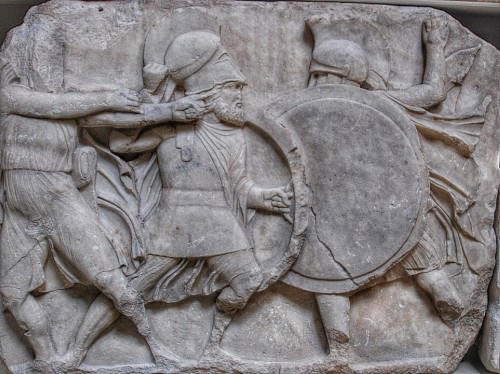
Greek Hoplites Fighting
LEGACY
Besides his influential role in the Peloponnesian War, Nicias also appeared as a character in Plato ’s philosophical dialogue, the Laches. In the dialogue, two friends have asked Nicias and Laches for advice on whether to train their sons in armoured fighting. Nicias says that they should, but Laches is against the idea. Socrates is then brought in to decide the matter, and the question evolves into a debate about the meaning of courage. Laches equates courage with perseverance, but this definition is found wanting. Nicias instead argues that courage is "the knowledge of what's threatening and what's reassuring in warfareand in all other situations" (Plato, Laches 194e). This sounds more promising, and in the equation of virtue and knowledge one might have expected Socrates to agree. However, Socrates argues that such knowledge must be the basis of all virtue, not just courage, and so the attempt to define courage ends in failure. The two generals were perhaps chosen as representatives of the military arts because they eventually ended their careers in defeat (Laches died at the Battle of Mantinea in 418 BCE).Thus, their failure to understand the true meaning of courage is ultimately connected with their failure as generals.
In Plutarch's biography of Nicias, he showed respect for Nicias' piety but described his nature as "timid and inclined towards defeatism" ( Life of Nicias, 2). It is likely that Thucydides knew Nicias reasonably well since they moved in the same aristocratic circles and, until Thucydides' own failure at Amphipolis, they were fellow Athenian generals in the early years of the Peloponnesian War. In addition, Thucydides' relative, Thucydides the son of Melesias, had played the same role in the 440s BCE as Nicias played from the 420s until his death: leader of the conservative faction in the Athenian assembly. Like Plutarch, Thucydides did not shy away from the fact that Nicias' personal qualities contributed significantly to the Athenian disaster in Sicily. Nevertheless, while discussing his pitiful end in Sicily, Thucydides lamented that Nicias, "of all the Hellenes in my time, least deserved such a fate, seeing that the whole course of his life had been regulated with strict attention to virtue" ( The Peloponnesian War, 7.86).
Putting aside his piety and virtue, Nicias was a competent if occasionally over-cautious general. He had enjoyed a successful if not outstanding military career before the Sicilian Expedition and, as a proponent of peace with Sparta, he had consistently opposed the war that would eventually destroy the Athenian Empire. Likewise, he was a firm adversary of the Sicilian Expedition, which caused such damage to Athens. So a case can be made that Nicias was the victim of an overly aggressive and expansive democratic assembly. His tragedy was that he dutifully took part in a reckless campaign which he suspected all along would end in disaster. There is certainly some truth in this position; however, it should also be remembered just how close the Athenians came to achieving victory in Sicily. Syracuse was on the point of surrender before Gyllipus arrived, so a more assertive Athenian strategy in the early stages of the campaign might have transformed the outcome. Later on, when it was clear that an Athenian victory was no longer possible, a more decisive general could still have saved the Athenian fleet and army by ordering a retreat before the Syracusans were able to blockade the harbour. The result would have been an embarrassment for Athens, but nothing close to the eventual catastrophe produced by Nicias' relentless hesitation.
Labyrinth › Antique Origins
Definition and Origins
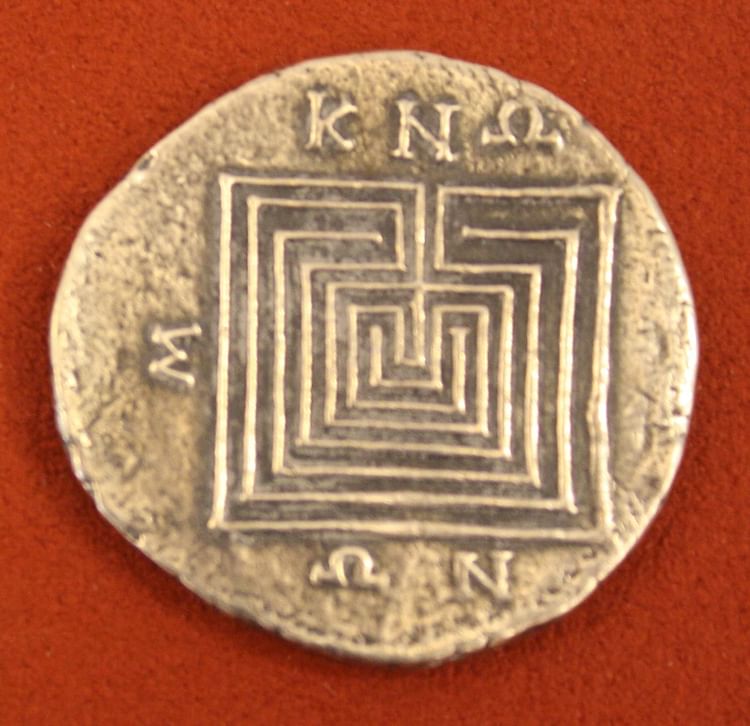
The word labyrinth comes from the Greek labyrinthos and describes any maze-like structure with a single path through it which differentiates it from an actual maze which may have multiple paths intricately linked. Etymologically the word is linked to the Minoan labrys or 'double axe', the symbol of the Minoan mother goddess of Crete, although the actual word is Lydian in origin and most likely came to Crete from Anatolia ( Asia Minor ) through trade.
Labyrinths and labyrinthine symbols have been dated to the Neolithic Age in regions as diverse as modern-day Turkey, Ireland, Greece, and India among others. In the Tantric texts of India, the labyrinth is often featured in the design of mandalas while in Britain and Ireland they are pre-figured in the ring-and-cup marks often found in stone work and the famous swirl designs found at sites such as Newgrange.
The labyrinth has been defined as distinct from the maze in that, as noted above, a labyrinth typically has a single path which winds through it while a maze can have many. Even so, the terms labyrinth and maze are often used interchangeably. The scholars Alwyn and Brinley Rees discuss the significance of the labyrinth-maze and why the design seems to have resonated so strongly with ancient people, specifically the Celts :
Much has been written during the past three decades about the ritual significance of mazes, both as a protection against supernatural powers and as a path which the dead must follow on their way to the world of the spirits.Here we will simply note that mazes are in relation to directions what betwixts-and-betweens are in relation to opposites. In passing through a maze one is not going in any particular direction, and by so doing one reaches a destination which cannot be located by reference to the points of the compass. According to Irish folk-belief, fairies and other supernatural beings can cause a man to lose his bearings…it is when the voyagers have lost their course and shipped their oars – when they are not going anywhere – that they arrive in the wondrous isles.(346)
The labyrinth/maze, then, may have served to help one find their spiritual path by purposefully removing one from the common understanding of linear time and direction between two points. As one traveled through the labyrinth, one would become increasingly lost in reference to the world outside and, possibly, would unexpectedly discover one's true path in life. The theme of the labyrinth leading to one's destiny is most clearly illustrated in one of the best-known stories from Greek mythology : Theseus and the Minotaur.
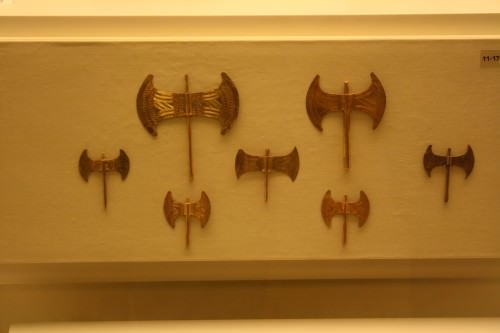
Minoan Double Axes
THE LABYRINTH OF CRETE
The most famous labyrinth is found in Greek mythology in the story of Theseus, prince of Athens. This labyrinth was designed by Daedalus for King Minos of Knossos on Crete to contain the ferocious half-man/half-bull known as the Minotaur.When Minos was vying with his brothers for kingship, he prayed to Poseidon to send him a snow-white bull as a sign of the god's blessing on his cause. Minos was supposed to sacrifice the bull to Poseidon but, enchanted by its beauty, decided to keep it and sacrifice one of his own bulls of far less quality. Poseidon, enraged by this ingratitude, caused Minos' wife Pasiphae to fall in love with the bull and mate with it. The creature she gave birth to was the Minotaur which fed on human flesh and could not be controlled. Minos then had the architect Daedalus create a labyrinth which would hold the monster.
SEVEN YOUNG ATHENIAN MEN & MAIDENS WERE SENT TO CRETE EVERY YEAR & THEN RELEASED INTO THE LABYRINTH TO BE EATEN BY THE MINOTAUR.
Since Minos was hardly interested in feeding his own people to the creature, he taxed the city of Athens with tribute which included sending seven young men and maidens to Crete every year who were then released into the labyrinth and eaten by the Minotaur. Daedalus' labyrinth was so complex that he, himself, could barely navigate it and, having successfully done so, Minos imprisoned him and his son, Icarus, in a high tower to prevent him from ever revealing the secret of the structure. Later, in another famous tale from Greek mythology, Daedalus and Icarus escape their prison using the feathers of birds bound together by wax to form wings with which they fly from the tower. Icarus flew too close to the sun, melting the wax of his wings, and fell into the sea where he drowned.
Prior to their flight, however, Athens was annually sending the 14 young people to Crete to be killed in the labyrinth until Theseus, son of King Aegeus, vowed to put an end to his people's suffering. He volunteered as one of the tributes and left Athens in the ship with the traditional black sails hoisted in mourning for the victims. He told his father that, should he be successful, he would change the sails to white on the trip home.
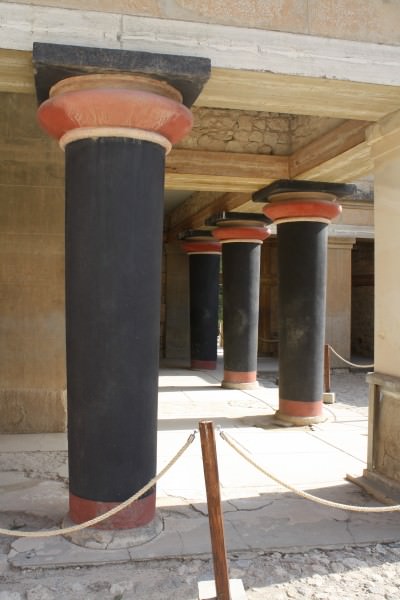
Labyrinth of Knossos
Once on Crete, Theseus attracted the attention of Minos' daughter Ariadne who fell in love with him and secretly gave him a sword and a ball of twine. She told him to attach the thread to the opening of the labyrinth as soon as he was inside and, after he had killed the Minotaur, he would then be able to follow it back to freedom. Theseus kills the monster, saves the youths who were sent with him, and escapes from Crete with Ariadne but abandons her on the island of Naxos on his way home. In his haste to reach Athens afterwards, he forgets to change the sails on the tribute ship from black to white and Aegeus, seeing the black sails returning, flings himself into the sea and dies; Theseus then succeeds him.
THE LABYRINTH AS SYMBOL OF CHANGE
Aside from its purpose as an origin myth – in that the Aegean Sea comes to be so-named for King Aegeus after his death – the story focuses on the coming-of-age of the prince Theseus and how he ascends to the throne. Theseus is the great hero who rescues his companions and delivers his city from the curse of the Minotaur but he is also deeply flawed in that he betrays the woman responsible for his success willingly and, unwittingly, causes the death of his father by forgetting to change the color of the sails.
THE LABYRINTH IN THE STORY SERVES AS THE VEHICLE FOR THESEUS' TRANSFORMATION FROM A YOUTH TO A KING.
The labyrinth in the story serves as the vehicle for Theseus' transformation from a youth to a king. He must enter a maze no one knows how to navigate, slay a monster, and return to the world he knows; he accomplishes this but still retains his youthful flaws until he is changed by the loss of his father and must grow up and assume adult responsibility. The labyrinth presented him with the opportunity to change and grow but, like many people, Theseus resisted that opportunity until change was forced upon him.
The archaeologist Arthur Evans (1851-1941 CE) uncovered what he believed to be the labyrinth at Knossos in his excavations between 1900-1905 CE. Although this claim has been challenged, the fabled labyrinth is still associated with the site of Minos' palace at Knossos and ancient writers reference it as an actual site, not a mythological construct. Evans was certain of his find and explained the mythological aspect of the Minotaur through the Minoan sport of bull jumping (shown in frescoes on the walls of the palace) in which, by grabbing the bull's horns and leaping back over the animal, man and bull appeared to be one creature.
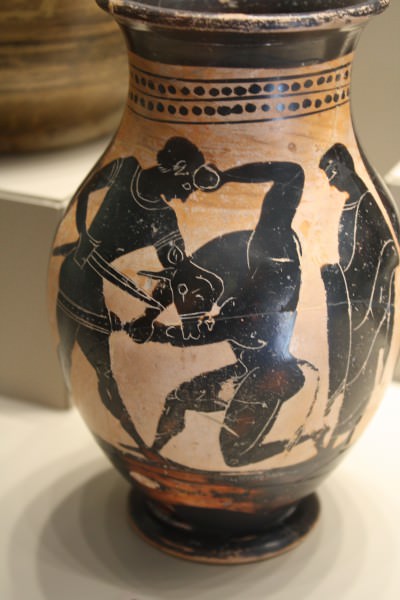
Theseus & the Minotaur
Whether there was a literal labyrinth at Knossos, however, is not as important as the meaning of the labyrinth in the story as a symbol of change and transformation. This same type of symbolism is also seen elsewhere and, notably, in the most famous labyrinth of antiquity: that of Amenemhet III (c. 1860-1815 BCE) of Egypt.
THE LABYRINTH AT HAWARA
The labyrinth at Hawara was so impressive that, according to Herodotus, it rivaled any of the wonders of the ancient world.Scholar Miroslav Verner notes that Amenemhet III's labyrinthine complex was “mentioned by ancient travelers” and continues:
Herodotus, Diodorus Siculus, Strabo, and Pliny all refer to it. According to Diodorus, Daedalus was so impressed by this monument during his journey through Egypt that he decided to build a labyrinth for Minos in Crete on the same model. (430)
The labyrinth was an Egyptian temple precinct of a pyramid complex comprising multiple courts built at Hawara by Amenemhet III of the 12th Dynasty during the period of the Middle Kingdom (2040-1782 BCE). This labyrinth was a mortuary complex grander and more intricate than any other constructed up to that time. The monumental structure is described by Herodotus:
I saw it myself and it is indeed a wonder past words… It has twelve roofed courts with doors facing one another, six to the north and six to the south and in a continuous line. There are double sets of chambers in it, some underground and some above, and their number is 3,000…The passages through the rooms and the winding goings-in and out through the courts, in their extreme complication, caused us countless marvelings as we went through, from the court into the rooms, and from the rooms into the pillared corridors, and then from these corridors into other rooms again, and from the rooms into other courts afterwards. The roof of the whole is stone, as the walls are, and the walls are full of engraved figures, and each court is set round with pillars of white stone, very exactly fitted. At the corner where the labyrinth ends there is, nearby, a pyramid 240 feet high and engraved with great animals. The road to this is made underground. ( Histories, II.148)
Strabo describes the labyrinth as “a great palace composed of many palaces” and praised it as “comparable to the pyramids ” in grandeur ( Geography, XVII.I.37-38). Diodorus notes how, “in the carvings and, indeed, in all the workmanship they left nothing wherein succeeding rulers could excel them” ( Histories, I.66) and Pliny states:
We must mention also the labyrinths…there is no doubt that Daedalus adopted it as the model for the labyrinth built by him in Crete, but that he reproduced only a hundredth part of it containing passages that wind, advance and retreat in a bewilderingly intricate manner. It is not just a narrow strip of ground comprising many miles of 'walks' or 'rides,' such as we see exemplified in our tessellated floors or in the ceremonial game played by our boys, but doors are let into the walls at frequent intervals to suggest deceptively the way ahead and to force the visitor to go back upon the very same tracks that he has already followed in his wanderings. ( Natural History, XXXVI.19)
It is believed that the labyrinth at Hawara, like any of the temple complexes in Egypt, mirrored the afterlife. There were 42 halls throughout the structure which Strabo associates with the number of nomes (provinces) of Egypt but which also correspond to the Forty-Two Judges who preside over the fate of one's soul, along with the gods Osiris, Thoth, Anubis, and Ma'at, at the final judgment in the Hall of Truth. The labyrinth, then, could have been constructed to lead one through a confusing maze – much like the landscape of the afterlife described in the Pyramid Texts, Coffin Texts, and the Egyptian Book of the Dead – to lead one toward an enlightened state.
This impressive complex fell into decay at some unknown point and was dismantled; the parts were then used in other building projects. So great was the site as a source of building materials that a small town grew up around the ruins. Nothing remains of this great architectural wonder today save the ravaged pyramid of Amenemhet III at Hawara by the oasis of Faiyum. Verner writes, “because of the early destruction of the complex, the original plan of the labyrinth cannot be precisely reconstructed” but notes how the archaeologist Flinders Petrie was the first to enter it in 1889 CE and concluded it was the same structure known as The Labyrinth in antiquity (428).
Scholar Richard H. Wilkinson notes that “it was one of the greatest tourist attractions of Egypt in the Graeco- Roman Period” and that the complex “represented an impressive elaboration of the established temple plan” (134). As temples were purposefully built as transformative sites, the labyrinth-as-symbol-of-transformation motif is as evident here as in the later story of the one designed by Daedalus.
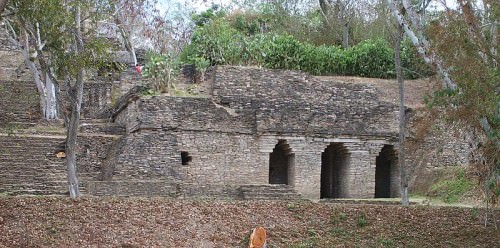
The Passages to the Underworld at Tonina
LABYRINTHS & THEIR MEANINGS
There have been many other labyrinths around the world since ancient times from the structure built in Italy as part of the tomb of the Etruscan king Lars Porsena (c. 580 BCE) to those of the island of Bolshoi Zayatsky (c. 500 BCE) in modern-day Russia. Celtic labyrinths are thought to have once been part of the mortuary rituals of Britain, Ireland, and Scotland and scholar Rodney Castleden notes:
Labyrinths constantly reappear in different forms at different stages in the evolution of Celtic culture and some of them are earlier than the Minoan labyrinths. The labyrinth as an idea is closely related to the knot: the line that winds all around a design. The difference is that, in a knotwork design, the line has no beginning and no end while, in a labyrinth, there is usually a starting point and a goal. Both symbolize journeys. This might be a particular journey or adventure or the overall journey of life itself. Labyrinths therefore form a visual counterpart to the epic folk-tale which often consists of a long and convoluted journey with episodes that repeat and double back on themselves. They may symbolize a journey of self-discovery too, a journey in to the center of the self and out again and, in this way, the ancient symbol emerges as a Jungian archetype: a tool for self-exploration and healing. (439-440)
This is certainly evident in the mandalas of Tantric literature from India and, most notably, in the Rigveda (c. 1500 BCE) in which the various books progress along the same lines as a labyrinth where one travels a spiritual path alone to eventually merge one's inner journey with the outer world. Carl Jung (1875-1961 CE) saw the labyrinth as a symbol of this reconciliation between the inner self and the external world. Scholar Mary Addenbrooke writes:
[Jung] describes the effect of being “gloriously, triumphantly drunk. There was no longer any inside or outside, no longer an 'I' and the 'others', No. 1 and No. 2 were no more (he is referring to his sense of having two dissimilar personalities within him); “caution and timidity were gone and the earth and sky, the universe and everything in it that creeps and flies, revolves, rises, or falls, had all become one.” (1)
Jung discusses the journey through the labyrinth in his Stages of Life :
When we must deal with problems, we instinctively resist trying the way that leads through obscurity and darkness. We wish to hear only of unequivocal results, and completely forget that these results can only be brought about when we have ventured into and emerged again from the darkness. But to penetrate the darkness we must summon all the powers of enlightenment that consciousness can offer... The serious problems in life are never fully solved. If ever they should appear to be so it is a sure sign that something has been lost. The meaning and purpose of a problem seem to lie not in its solution but in our working at it incessantly. This alone preserves us from stultification and petrifaction. (11)
The people of the ancient world seem to have understood this concept long before Jung articulated it so eloquently. The labyrinth, finally, is the journey of the self to wholeness. Although the ancient Egyptians or Greeks may not have phrased it this way, their architecture and myths point to the same conclusions Jung and other later psychologists have come to: that it is in working one's way through the labyrinth of one's present circumstances that one comes to realize one's purpose and a final meaning for existence.
LICENSE:
Article based on information obtained from these sources:with permission from the Website Ancient History Encyclopedia
Content is available under License Creative Commons: Attribution-NonCommercial-ShareAlike 3.0 Unported. CC-BY-NC-SA License